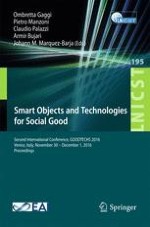2017 | Buch
Smart Objects and Technologies for Social Good
Second International Conference, GOODTECHS 2016, Venice, Italy, November 30 – December 1, 2016, Proceedings
herausgegeben von: Ombretta Gaggi, Pietro Manzoni, Prof. Claudio Palazzi, Armir Bujari, Johann M. Marquez-Barja
Verlag: Springer International Publishing
Buchreihe : Lecture Notes of the Institute for Computer Sciences, Social Informatics and Telecommunications Engineering
